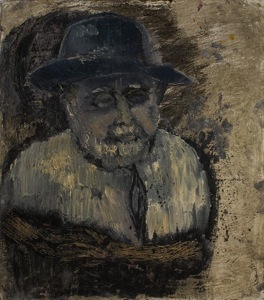Lev Meshberg, artist, Carrara, Italia, 2004
TJAARKE MAAS
I have just arrived from Paris after saying farewell to Misha Raginsky, an outstanding painter. While checking the answering machine, I heard the crying voice of Yurochka «Lusik, Lusik Tjaarke had left us». And after that message followed another, and the word - funeral.
I could not believe it. Just the other day we were at the exhibition in Bologna. Tjaarke, - was a marvel, an incredible talent, clever, beautiful, with the fine sensible understanding of music, freely speaking in many languages, good-natured, gentle and a great artist. It was only that spring that she graduated from the Florence Academy of Fine Arts. The diploma was unique, and it received the highest rating.
Her gift was from God, she was not in pursuit of fame, her works breathed with tremulous life, her touch to the canvas, wood-board, was a true spiritual act.
She was, a born-to-be painter, the finest draftsman, striving for harmony, without any attempt to impress or shock anyone, with out any banality. Her works has lived, trembled. I remember how she painted in my presence a portrait of an elderly Italian man, Jean Carlo, with a cigar in his mouth. I often visited them in Fiesole, and have seen this gentleman in a cafe. A good-natured, calm man with a bulky body, flickering, puffy hands, bringing to his mouth an always-glowing cigarette with a good, farewell smile. How touching she conveyed on canvas his image. He was her friend. Or the portrait of Dmitri Ivanov, in the green, with barely perceptible outlines. Here stands before me a still life with an old wilted pomegranate and a bottle on a green background. Only an outstanding artist could produce this green color. She had been a real aristocrat of painting, her batch was without the bothersome smears, a true nature, not of that imitating kind, looks alike, but the one which stands in a parallel reality, without any naturalism. She had possessed a profound combination of intellect and the divine gift that is the essence of art.
Here is a still life, the hand carrying a golden cup; the gold came from a Russian icon. She was an amazing icon-painter, and did it using all technological rules, putting her pure soul into each one. In our time it was quite unique, as she carefully selected color pigments, prepared boards, levcas, chisel to dislodge the plane icon. Into the icon painting, she invested all of her spirituality which in turn passed down to the spectator, and what a choice she made of the subtlest colors. Before our eyes, she revived the long-forgotten secret genius of Russian icons.
All these things were done by Tjaarke, a young Dutch woman, almost a girl. That was indeed a mystical penetration into the Russian spirituality. The young Italian people flocked to her to learn iconography.
Before my eyes is a charcoal drawing of pigeons. It is a big series. Each broadsheet, in its flexibility displays this unusual bird - the endless variations of the movements. She was always with her sketchpad; her eyes would literally grab the object that she drew. She was one of those rare artists who clearly felt the proportions, and was able to catch everything with the extraordinary similarity, and this similarity was, the image and essence of the object she was depicting.
She was absolutely not interested in comfort at work. Often she painted on her knees and even in an awkward position, the material that she used could be old plywood or decaying wood-board. We walked through Fiesole and she often would bow down, touching and gleaning a beautiful flower or a stone, she knew all the dogs and cats, and what stories she would tell me about the turtles, which lived in her yard! Sitting on the balcony and working on a shaky table, birds always surrounded her, and she looked like a stork. Tjaarke always wore a tight lilac hat, and had light blue eyes, and her charming smile enshroud goodwill.
She has created a remarkable series of portraits, no clichés, no learned colors, no flesh-colors; each portrait was conceived with its own color corresponding to the character of the model. There was no established factory; each piece was painted directly, ingenuously. The works she created constantly elevated in standard and quality, each one was better than the previous one. Together we laughed when she told me that one professor of the academy strictly forbade the students to paint flowers. She was inclined to the idea that you can paint all the objects, but how to paint them was the most important.
How we enjoyed together the flowers by Giorgio Morandi in his museum in Bologna. We had carefully investigated the objects of Morandi, and she very finely observed:
»Look Lev, what an unenviable little vase, but how it looks on the canvas of Morandi» »
Tjaarke, extraordinary Tjaarke was at the height of creativity. Her motherland Amsterdam contains thousands of daubers of the canvases. Dutch visual arts, the country that gave birth to a disproportionate amount of great artists, are now below sea level.
Where are you amazing, sensitive, compassionate Dutch eyes? How could such a loss happen? How could Holland not have taken care of her daughter, her “darling”? Did the Van Gogh lesson teach nothing?
I do not write memoirs, no obituary, because Tjaarke will live in her works, always, because artists do not die - they just go from one painting studio to another. What I wrote is probably «The Cry» of Edvard Munch.
Lev Meshberg
Carrara 2004

Tjaarke Maas "Lev Meshberg"
